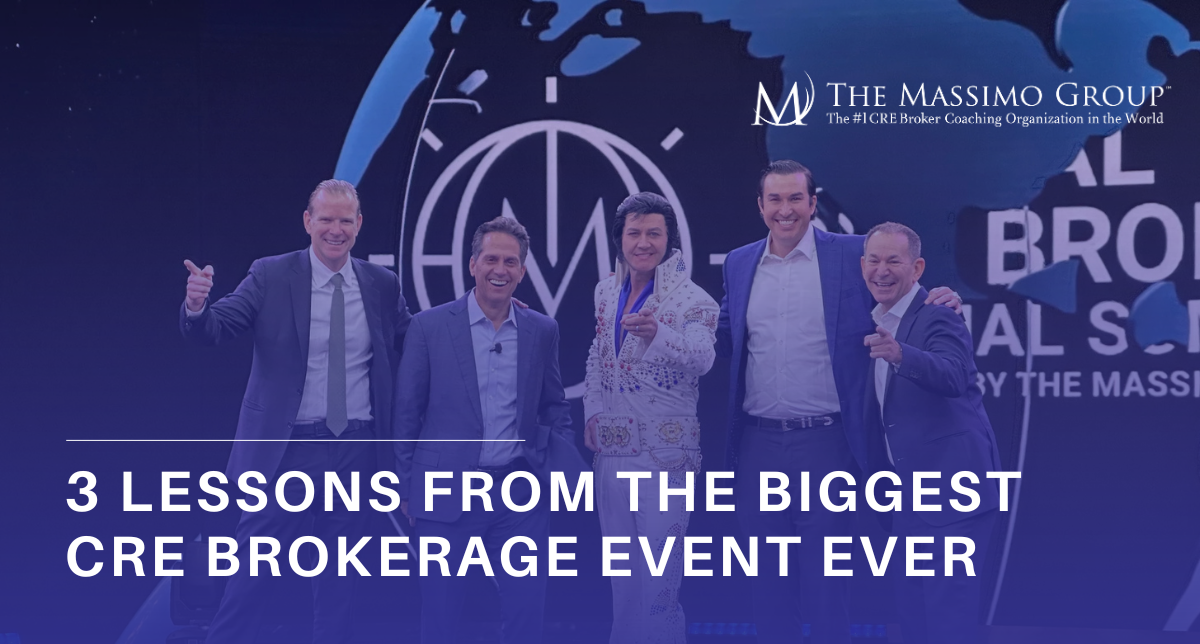If you haven’t figured out my blogging cadence yet, I write a commercial real estate business blog twice a week. From there, our team posts to our website, all LinkedIn Groups, and then to our weekly newsletter on Saturdays — The Massimo Minute. In addition, our team takes the content of my blog and creates a series of tweets for my Twitter account. Using this approach, I can focus on what I enjoy — writing — while my team is able to maximize its distribution, and hopefully its readership.
For many, including me, writing a blog in such frequency can be a challenge. More importantly, you want to create content that actually gets read. It’s a lot of work to get a blog written, published, and distributed. The work is wasted unless you get your readers to click on your content.
Over the years (in October we will celebrate our 10-year anniversary) I have figured out there are certain aspects of a blog that not only enhances readership, but turns readership into qualified prospects.
The first step in getting any blog read is the title. Most likely you didn’t open this email because of the word “content”. In fact, that word probably turned away a good segment of the commercial real estate population. That’s unfortunate. Not only did they miss a great article (hee, hee), but they don’t realize the prospecting power of creating sound content.
It’s more likely you opened this blog based on the promise of “prospects”. After 9 years and thousands of blogs, we have determined the right keywords for getting our content opened. When it comes to the commercial real estate professionals, the top 2 words are “Prospecting” and “Commissions”, in that order. Other keywords are “Time”, “Team”, and “Income”. Why? Because these are key concerns of our commercial real estate audience.
Other words that have worked well in titles include “Trump” and “CoStar”. The rationale is simple — both words incite passion. Love or Hate, it doesn’t matter. Both of these words have worked well in 2018.
For you to create a following and readership, you need to determine the keywords that resonate with your audience. “Rent reduction”, “Record Low Cap Rates”, “Record Low Interest”, and “High Demand” are some phrases that will play well in the commercial real estate brokerage space. Likewise, think of hot buttons or timely issues like “1031 is being distinguished” or “Trump’s Tax breaks for Property Owners”. Again, these will incite passion, and thus readership.
Personally, I read — and read a lot. Books, blogs, e-news, etc. This provides me a wealth of ideas for content that is timely. You can easily do the same. Perhaps there is a key issue in your local market, or a transaction that will have a wide range impact or a certain person that everyone is talking about.
Of course, getting your blog read is only the first part of the equation. Now you must provide solid content to keep your audience coming back. We will address that next.
If you have made it to this part of the blog, then there was something of interest that lured you to continue reading. That’s the point. What subject matter and promise of value can you provide your targeted audience to engage them in your material? I offered a lesson on converting prospects to clients. This had an interest to you, otherwise, you would not be reading this sentence.
Potentially you have a list of solutions for a tenant who is expanding, a business that is closing, or an owner who is considering refinancing. Maybe you just dealt with a specific issue in a transaction that is prevalent in your market and you know others would be interested (air rights in New York City, property insurance in Houston and FL).
Certainly, the first place you should leverage your content is your personal transactional experience, from there you can expand to recent market transactions and trends. These variables alone provide you with a wealth of information to create applicable content to a target audience. Identify the issues, players, and impacts on decision makers, shareholders, stakeholders. This approach is one of the best ways to design an entire year of content.
Additional sources of content are other blogs, newsletters, research reports, and industry news. When using these sources for your content, it is vital that you craft a story that has value to your targeted audience. Your conversion ratio of readers to followers to influencers to prospects, is much greater when you have a targeted message to a specific audience.
Digital marketer guru, Greg Schraff of Digetry provides some answers on how to generate interesting blogs that people will actually want to read. Here is his list, expanded on to be relevant to our readers.
1. WRITE ABOUT YOUR INDUSTRY, NOT YOURSELF. Many CRE brokerage owners make the mistake of writing about their own firm and the service they provide. But people aren’t searching for things specific to your business, they are searching for things specific to themselves — for example, how to solve or address a specific challenge. Including your own services in your blog will erode trust and come across as a sales pitch — and no one wants to read a sales pitch.
2. WRITE ABOUT COMMON PROBLEMS. People are searching for solutions to their problems. Blogs need to address these problems and provide answers to them. Put yourself in the shoes of your clients and prospects and think about what information would be relevant, compelling, and useful to them.
3. IDENTIFY THE QUESTIONS YOUR CUSTOMERS ARE ASKING. One great way to write about the problems that your customers are looking for answers to, is think about the questions your prospects have. Write down *all* of the questions your customers would have about your product or service. Your answers to these questions become your blog posts!
4. FOCUS ON ONE TOPIC PER BLOG POST. Simplify blogging by keeping things simple. While writing your commercial real estate blogs you may generate a bunch of related ideas and topics. Write about one topic per blog and one topic only. Staying focused will make your blogs more powerful and memorable. And, you can pull out the additional ideas and use them for future posts!
5. DON’T TRY TO COVER TOO MUCH GROUND. Look at your topic and ask yourself if there are sub-topics that fall underneath it. For example, you could write about sales, but sales are made up of prospecting, lead generation, the sales pitch, the proposal, the close, etc. Each one of these subtopics are separate blogs. Writing shorter, more concise blogs make for a more compelling read.
FOLLOW THESE STEPS WHEN WRITING YOUR COMMERCIAL REAL ESTATE BLOGS AND YOU WILL END UP WITH UNIQUE, EDUCATIONAL CONTENT THAT WILL ATTRACT CUSTOMERS AND BUILD TRUST.
I’d love to hear about your experience, or questions related to blogging. If you have some best practices, please share these as well.
If you’re interested in taking your blogging AND your personal brokerage business to the next level, you can schedule a free consultation with one of our Program Consultants by CLICKING HERE.






5 Responses
Well done! Content Titling is key! Mix in authenticity and consistency and you’re golden.
Great advice! Thank you for all you do for our industry.
This year we starting searching google to help us discover the most requested questions found on google. Our research turned up 20 questions we will use next year to do our marketing.
We are now writing series, which makes coming up with ideas easier. One topic can generate a lot of ideas. Next year I will focus on how to purchase a commercial building and interesting/unusual design for commercial buildings.
I keep promising myself I will find someone else to write my blogs, but not sure how they could, as they don’t have the experience to know what to write. Just like Rod, I do the initial writing and then it goes to others to get ready for publication. The one area I’m different than Rod is in when I put together the content. I write all the series in August for the following year. Once the new year is here we add success stories and the articles we use in prepare for our newsletter.
Is it worth it? YES!!!!!!!!
I would like to get in contact with Lynne Drake.
I am a Massimo subscriber / member.
My e-mail is [email protected] and telephone 760 964 1004
I am an agent with Coldwell Banker Commercial in California
Rod,
Excellent advice.
It is almost all about the audience/viewer and their needs, issues that can or eating away at their bottom lines amongst other important issues and giving them some steps (not all), but just enough to let them know that you and or your Company is a “specialist” that can solve or help them to avoid those problems that you raised!
Regards,
Howard Applebaum
Corporate America Realty & Advisors